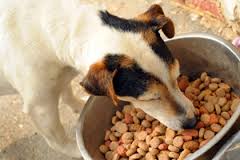The following information is primarily for dog owners (as cats and other animals have different dietary needs), but knowing what is in the food versus what is not in it, is important across the board.
In recent years it has become easier and more likely for the average consumer to examine the ingredients list on your dog’s food bag to see what they are eating; but have you ever looked at what your pet is eating? If we look at the front of a dog food bag, which is probably how most of us pick our foods you are likely to see bright colorful packaging with pictures of fresh meat, grains, produce, and happy, healthy dogs. There may also be bold claims of ‘prime cuts’ or ‘meatier’; but how honest is the packaging and these claims? Would you be surprised to learn that a package could show a beef stew but be made almost entirely of wheat or corn? 
A very popular brand in a bright yellow bag states ‘Chicken Flavor’ and ‘Meatier Recipe’; but upon examination of the ingredient list, we find the first mention of chicken (listed as ‘chicken by-products’) to be the seventh item on the list. The primary ingredients of that particular food is corn, with ‘Meat and Bone Meal’ listed as well, but the kind of meat is not known. Would you ever grab a package at the supermarket labeled ‘Meat’ for dinner? Hopefully not; so why feed that to your dog? According to multiple sources, this can be slaughtered or euthanized animals not fit for human consumption, road kill, and expired meats along with the Styrofoam packaging.
Flavor (as the above food used) is a term that the Association of American Feed Control Officials (AAFCO) allows to be included on labeling, but producers are only required to provide enough product to be detected in laboratory testing. Formula requires at least 25% which can also be split with other ingredients (such as chicken and rice). With must contain at least 3% of the named ingredient.
Terms that have no AAFCO definition include Weight Management or Weight Control, Super-premium, gourmet, or holistic and are just buzzwords to get your attention on packaging. If you are looking for organic foods, look for the USDA seal.
Dogs do not require a carbohydrate (starch) component in their food, but dry kibble does need a starch component to be made (it is part of a process where the starch melts and helps bind the kibble together called gelatinization). The type of starch can vary and there are some types better than others such as sweet potatoes and whole grain rice as opposed to corn or brewer’s rice (which are fragments of milled rice containing fewer nutrients) .
.
So what should you be looking for in a good quality dog food? Overall, a basic rule of thumb is that the more named meat items in the first 5 ingredients, the better the food. Foods listed without Meal listed behind them will always fall a little further down the list by weight after cooking (Turkey, Chicken, Beef, Lamb, Salmon, etc). ‘Meals’ are animal products that have already been cooked down and may or may not include some bone (which increases the calcium content).
A slightly more accurate rule of thumb would suggest that you should consider all the ingredients before the first mention of FAT, as that is the last significant ‘weight’ added to the kibble, everything after is generally flavor, preservatives and added nutrients.
Try to avoid food coloring, artificial preservatives (like BHT, BHA, and ethoxyquin), sugars, and sweeteners. Additionally, consider your pet’s treats as well, many popular types contain many of the things that should be avoided. Finally, do a little research on your own, sign up for email updates of recalled foods, consider what your pet is eating, and he will love you for it.
A few websites that may be of help:
http://www.dogfoodanalysis.com/
*If you have been instructed by a veterinarian to use a specific food please seek their advice before switching food.

Recent Comments